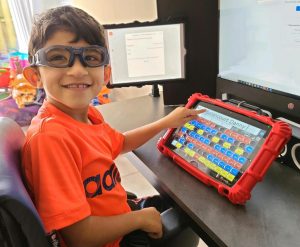AAC: Myths and Facts
AAC: Myths and Facts
What is Augmentative and Alternative Communication?
Augmentative and Alternative Communication (AAC) is a mode of communication wherein strategies, tools, and devices are used to supplement or replace spoken language. These devices are required for children & adults who have speech impairments.
Some individuals prefer communicating by maintaining a notebook and them writing as a mode of communication. Others prefer gestures in order to communicate. You might have also seen children using pointing as a mode of communication. Some people choose to use one or more of these types of communication strategies. These are a few examples of different types.
What are the benefits of using AAC?
- Provides better communication access
- Reduces frustration among individual
- Increases social integration of the individual with their community
- Improves self-confidence
- Improves the opportunities for educational & literacy development
- Creates work opportunities
- Improves the communication independence
Even though there are several benefits, there are several myths that surround the usage of Augmentative and Alternative Communication. Following, are several myths that need to be eliminated. We can do this by creating awareness on the facts.
-
AAC may hinder my child from developing expressive language & can worsen their speech delay: FALSE
There is research evidence to support the fact that AAC facilitates speech and language development in children. Even for very young children, it does not hinder speech & language development.
-
AAC is the last option for my child: FALSE
Alternative & Augmentative Communication devices facilitate communication. Keeping it as a last resort means that you are depriving your child of communication. We as individuals communicate in various ways. Some examples are gestures, facial expressions, body language, sign language, etc. We use more than one of these for communication. And AAC is just another mode of communication. The sooner we start communicating with these devices, the better the communication outcome.
AAC can be integrated with Speech therapy. When these devices become a part of communication, it helps in the quality & ease of communication
-
My child is not ready to use AAC. Let’s wait till they get older: FALSE
Children as young as 18 months of age can use AAC to communicate. These devices can be used by anyone of any age range. Even older adults use these devices. Thats why, its important to remember, that it is never too late to start implementing them.
-
High tech AAC may be too much for my child. Let’s start with a simple low tech device: FALSE
You can start using any device based on your child’s needs. Whether it’s a low-tech device or a high-tech device. However, it is not necessary that you transition from a low-tech device to a high-tech device later. Start using the high-tech device from the beginning itself.
-
My child can communicate to me about their basic needs, so AAC is not required for them: FALSE
Communication is much more than communicating about your personal or basic needs. It’s not just about saying “Hungry” or “Water”. As your child grows, you will understand that there so much more to communication. Their intentions change. There is a development in language that takes place. So as your child grows, they might want to visit the restaurant. Independently use the device. They would want to say “I want to eat a Chicken Sandwich”. Or “Can you pass me the glass of water?” Thus, its more than basic needs.
-
You need to have good cognitive skills to use AAC. Only people with high IQ scores can use devices successfully: FALSE
It is unknown whether cognitive skills are a pre-requisite to use AAC. Irrespective of cognitive skills, they have been used successfully. It is, however, of utmost importance, to presume competence. Regardless of the cognitive skills, that everyone has something to communicate. Everyone has the ability to learn. Augmentative and Alternative Communications have been proven to facilitate functional cognitive development.
-
Children must have good vision, hearing, fine motor skills/ manual dexterity to use their AAC: FALSE
Various modifications can be made to an AAC device. This depends on the multiple anomalies that a child has. Some modifications used are additional pointing tools, keyboard modifications, font modifications, icon sizes, text to speech, etc. If your child has any or many anomalies, a customized AAC would give the best communication.
-
AAC increases my child’s screen time: FALSE
It’s unclear whether using an AAC device has similar effects on the brain as general screen time. Until we know for sure, we cannot be blind to the potential hazards of screen time. However, we also cannot dismiss the benefits of using a screen device to communicate.
-
AAC is only for children who are non-verbal: FALSE
AAC is for any person regardless of age or gender. It is for those who have limited understandable speech for communication. These devices are used when speech is not reliable. It can be used along with persons with expressive abilities to give them independence, better vocabulary, and have better conversations. They also help in developing language & literacy skills. Having a few words is great, but it is not nearly enough to communicate with unfamiliar persons or situations.
-
AAC implementation is a Speech-Language Pathologist’s job: FALSE
AAC assessment for children is planned & done by a Speech-Language Pathologist. However, it takes the parents, teachers, and other communication partners to help the child to use/ implement the device for the best intervention outcome.
At the end of the day, it all comes down to communication. Communication is the true essence of human life. It is also the basic right of every citizen in this world. We need to accept and normalize every mode of communication whether it is verbal, non-verbal, or both. We can do this only once we debunk the myths by accepting the evidence-based facts.
- Tips to Promote School Readiness - February 28, 2023
- Baby Sign Language - February 24, 2023
- Summer Speech Activities for Children - February 21, 2023



Leave a Comment
(0 Comments)